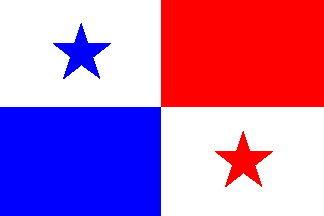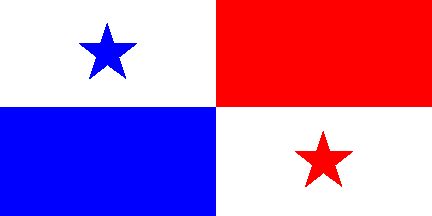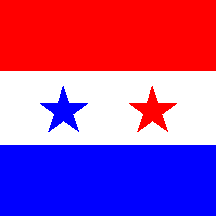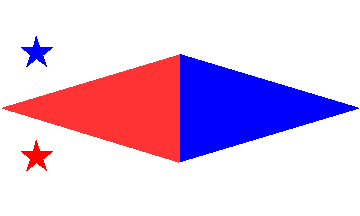
2:3
image by Ivan Sache, 23 june 2002

Last modified: 2006-02-18 by dov gutterman
Keywords: panama | america | star (blue) | star (red) | star: 2 | central america | colon |
Links: FOTW homepage |
search |
disclaimer and copyright |
write us |
mirrors

2:3
image by Ivan Sache, 23 june 2002

1:2
image by Ivan Sache, 23 june 2002
Flag adopted 20 December 1903
coat of arms adopted 4 June 1904 and legislated officially 15
December 1949.
Official Name: Republic of Panama (Republica
de Panama)
Capital: Panama
Location: Central America
Government Type: Constitutional Democracy
Flag adopted: 28
March 1941 (First hoisted 20 December 1903)
Coat of Arms adopted: 4 June 1904
ISO Code: PA
See also:
Other sites:
The current national flag was confirmed by Law 48 of 1925, and
ratified by law 28 of 28 March 1941. The blue and red is for the
Conservative Party and Liberal Party; the white is for peace; the
blue star is the purity and honesty of the life of the country;
the red star is for authority and law in the country.
Jaume Ollé, 4 September 1996
From <www.pa/patria/simbolos.html>,
located by Jarig Bakker:
Flag of Panama
The Panamanian flag was design by Mr. Amador Guerrero and made by
[his wife] Ms. Maria Ossa de Amador.
The Panamanian flag is a rectangle divided into four quarters:
the top hoist one, white with a five-pointed blue star; the top
fly one, red; the bottom hoist one, blue; and the bottom fly one,
white with a five-pointed red star
The combination of its three colours has this meaning: white
stands for the long-expected peace through the pacifical union of
the historical parties, the Liberal one represented by red and
the Conservative one by blue.
Baptism of the Flag
On December 20th 1903 the emblem was baptised, acting as
Godparents [sic] Dr. Gerardo Ortega with Ms. Lastenia de Lewis
and Mr. José Agustín Arango with Ms. Manuela M. de Arosemena.
Rev. Fray Bernardino de la Concepción García gave his blessing.
Legal adoption of the Flag
The Constituent Assembly provisionally approved the flag by Law
64 of 1904. It was definitively approved through Law 4 of 1925
written by the National Assembly and ratified by Law of March
28th 1941.
Translated by Santiago Dotor , 13 December 1999
From Smith [smi75]:
"The orderly division of the field suggested alternation of
the parties at the helm of the government. blue and red were also
associated with the Atlantic and Pacific Oceans, which flank
Panama."
From DK Pocket Book [udk97]:
"Red was the colour of the Conservatives and blue that of
the Liberals." Error?
Ivan Sache , 26 December 1999
Crampton - The World of Flags (1990: '...it is said that its
colors stand for the Colorados (the "Reds", or radical
party) and for the Conservatives, the traditional parties of the
time, with white for peace. It was designbed by the first
President, Manuel Amador Guerrero, and first hoisted on 20
December 1903...'
The Encyclopedia (1999): 'The blue and red are the colors of the
main political parties (Conservatives and Liberals respectively)
and the white denotes peace between them. The blue also
symbolizes the Pacific Ocean and the Caribbean, and the red
stands for the blood of those who lost their lives for their
country. The blue star represents the civic virtues of purity and
honesty, and the red star is a symbol of authority and law.'
Jarig Bakker , 26 December 1999
A friend of mine told me that in the recent events of
retrocession of the Canal, Panama National Flags sere usually
seen in ration 1 : 2 can anyone confirm ?
Armand du Payrat, 28 December 1999
Smith is totally incorrect, DK Pocket Book is incomplete.
Crampton - The World of Flags (1990) got the red Liberal party
wrong and the designer was Manuel Amador Jr., not the President
Manuel Amador Guerrero. The Encyclopedia (1999) is accurate
and complete.
Alvaro Aguilar, 31 August 2001
According to [pay00] -
National flag (2:3) and (1:2). Measurement of stars from both
Album and Flaggenbuch gives for diameter of the stars 30% of the
flag hoist. Album, as well as Smith, has the FIAV grid totally
filled for this flag, thus meaning it is used on land as civil,
state and war flag and at sea as civil, state and naval ensign.
Smith gives the flag proportion as approximate 2:3. Album shows
the flag in proportion 2:3, but caption says 2:3 and 1:2.
Approximate colour specifications in Album are:
Red: Pantone 186c - C0:M90:Y8:K5
Blue: Pantone 300c - C100:M45:Y0:K0
Anything on other flags such as a Prsidential flag, for instance?
Ivan Sache, 23 june 2002
I would pssibly have chosen some darker shade of blue to draw
this. In any case, [smi82] show
the blue rather dark, and some other sources also choose darker
(if maybe not so dark one). Possibly there is a realtion with US
shades? Then maybe not.
Not that I am aware of any other flags. Nither Flaggenbcuh, not
Smith nor National Geographics mention any other flags. n fact
Crampton in [cra90f] clearly says
in the "Other flags" field "None."
Željko Heimer, 23 june 2002
Does this mean that Album gives construction details? As far
as I can see no two flag books picture this flag with the same
ratio for the stars. Most sources appear to agree that the shade
of blue should be the same as that used in the flag of Costa Rica.
There also appears to be some variety on the history of this flag
and the proposal before that, but do we know what the first
version of this flag looked like?
Siegel [sig12] describes both
stars as red, but the images does show the current flag.
Peter Hans van den Muijzenberg, 7 July 2002
The website <www.pa/patria/simbolos.html>
(located by Jarig Bakker) has the text of the 1949 decree on use
of the flag. Article 2 has the following to say about
proportions: "Article 2: The Flag of the Republic has the
following dimensions: three meters in length by two in
width for those flown on public buildings, warships and merchant
ships; one meter 80 centimeters in length by one meter 44
centimeters in width for the colors [pabellones] of units of
infantry and artillery; of one meter square [for t]he standards
of cavalry[.] [F]lags for official automobiles will measure
47 centimeters in length by 32 centimeteres in width."
My brackets are my emendation of a text that, on the website,
actually says "...infantería y artillería; de un metro
cuadrado. Los estandartes de caballería y las Banderas de los
automóviles de uso oficial medirán ...." This makes
sense to me only if the period after "quadrado" is
changed to a comma and a new sentence is begun after
"caballería." Otherwise the phrase "de un
metro quadrado" doesn't apply to any flag, and the poor
cavalrymen are left carrying an absurdly small standard.
The same site also has rules for vertical hoisting/rotate and
reverse so the blue star is in the flag's upper right and the red
one in the flag's lower left.
Joe McMillan, 20 September 2002
This gives ratios 2:3, 4:5, 1:1 and 32:47. The Album mentions
possibility 1:2. Is there any legal background for that?
Sadly enough, the regulations says nothing on the size of the
stars. Ivan estimates them to 30% of hoist, based on Flaggenbuch
and Album.
Željko Heimer, 23 September 2002
The Mariner's Handbook, edit 0999, British HO Taunton,
presents it as 1:2
Armand du Payrat, 23 September 2002
Note that the 4:5, 1:1, and 32:47 ratios are for very
specialized uses.
Joe McMillan, 23 September 2002
One may then say that the Panamian flag is simply 2:3, as we
do for the others too. However, the main point I wanted to ask
was regarding the 1:2 ratio, which seems is not legally
sanctioned, but apparently used. I wander if the use of that long
flag might be happening only as an ensign - Panamian ensign is
among the most popular flags of conviniance, and therefore there
certainly are many ships carrying ensigns that not only are
produced abroad Panama, but probably haven't seen Panamian coasts
ever. If 1:2 version is not frequent unofficial variant - we
might want to drop it alltogether.
Željko Heimer, 24 September 2002
According to [pay00] -
National Flag (CSW/CSW 2:3 and 1:2) - Size of stars is estimated
on FOTW to 3/10 of hoist.
Željko Heimer, 7 October 2002
Panama's Flag Day (Día de la Bandera) is on November 4th.
Source: <www.pa>.
Jim, 23 January 2006

image by Ivan Sache, 10 October 2005
Photo at <www.epasa.com>
show vertical hoisting of the flag. The flag is rotated 90
degreed to the right while the stars are kept in their original
orientation, which means that it is a regular flag,
only rotated.
Dov Gutterman, 10 October 2005
coa.jpg)
image from <www.epasa.com>
Here are an old Coat of Arms and
the shield.
Fred Drews, 21 November 1999
From <www.pa/patria/simbolos.html>:
The National coat-of-arms was designed by Mr. Nicanor Villalaz
with the help of his brother Sebastián Villalaz. (see here)
Jarig Bakker and Santiago Dotor , 13 December
1999
This image of unclear origin is outdated. Pedersen [ped71], as well as [smi75] and [udk97], shows NINE STARS above
the shield, corresponding to the nine provinces in which the
country is divided. There are now also three indigenous
districts, including the "Comarca de San Blas", a.k.a.
"Kuna Yala" inhabited by the Cunas
Indians .
The description of the arms is in [smi75]:
"'For the Benefit of the World' [Pro Mundi Beneficio]
proclaims the motto of Panama, referring to the canal which
divides the country physically but provides it with a substantial
portion of the national income. The arms incorporate other
symbols as well. The civil wars of the past, represented by saber
and rifle, have given way to the tools of peaceful labour,
promising the prosperity and progress symbolized by the
cornucopia and winged wheel. The sun and moon both appear in the
central panel of the shield to indicate that independence was
achieved at the hour of twilight. The green background of the
coat of arms (official, but rarely shown) is a reminder of the
nation's tropical vegetation."
[udk97] has again a problem with
colours: in the image of the arms, the red and blue stars are
inversed in regard of the image above and [smi75] image!
Ivan Sache , 26 December 1999
The coat of arms from <www.epasa.com>
is incorrect. The coat of arms From <www.pa/patria/simbolos.html>
is correct. According to <panama.mipueblo.net> (defunct),
the coat of arms "was adopted by Law 64 of 4 June of 1904
signed by the President of Assembly Dr Genaro Ortega, and
sanctioned by the President of the Republic, Dr Manuel Amador
Guerrero..."
"From a careful investigation comes off that the first
sketch of the coat of arms, devised by his author, Don Nicanor
Villalaz, was drawn by Don Ricardo Miró that in addition to
being a poet, was a fan of drawing. The second sketch, from which
the cannon and the gun carriage, the sickle and the machete, the
handful of ears and the cluster of banana trees were suppressed,
and replaced the train for a winged wheel, was painted by
professor Max Lemm, German artist resident in Panama....
"The coat of arms approved in 1904, and that since then it
was used officially, has the following description:
"It rests on a green field, symbol of the vegetation; it is
of pointed form and it is intervened as far as the division. The
center shows the Isthmus with its seas and sky, in which the moon
begins to rise above the waves and the sun begins to hide behind
the mountain, marking thereby the solemn hour of the declaration
of our independence. The head is divided in two quarters: in the
one of the right hand, in the silver field, a sword and a gun are
hung meant as abandonment for always to the civil wars, causes of
our ruin; in the one of the left-hand side, and on field of
gules, a crossed shovel and a grub hoe are shown shining, to
symbolize the work "
"The end of the coat of arms also is divided in two
quarters: the one of the right-hand side, in blue field, shows a
cornucopia, emblem of the wealth; and the one of the left-hand
side, in field of silver, the winged wheel, symbol of the
progress. Behind the shield and covering it with his opened
wings, is the eagle, emblem of the sovereignty, the head turned
towards the left, and takes in the tip a silver tape, which hangs
from right to left. On the tape the following motto is printed
"Pro Mundi Beneficio "
"On the eagle, in arc form, seven gold stars go in
representation of the provinces in which the Republic is divided.
Like decorative accessories, to each side of the coat of arms two
gathered national flags go on the other hand below"
For thirty-seven years the Coat of Arms of the Republic of Panama
was not changed until the Constitution of 1941 was promulgated.
The National Assembly dictated in March of this year Law 28 on
the Coat of Arms, in which the following reforms were introduced:
the saber and the gun are meant as attitude of alert in defense
of our sovereignty, in the place of "abandonment to mean
good bye to the civil wars ". 311 projects
appeared to change the motto and the Jury named to make the
selection decided for: "Solo Dios sobre Nosotros" (Only
God Above Us). Nevertheless, the National Assembly when approving
the Law 28 already referred to, rejected it and preferred the one
of "Justice, Honor and Freedom ". Five years
later, in 1946, Panama returned to the old symbol with the
well-known motto of "Pro Mundi Beneficio ".
Alvaro Aguilar, 31 August 2001

roundel
image by Ivan Sache, 23 june 2002

fin flash
image by Ivan Sache, 23 june 2002
According to [pay00] - Aicraft
marking - The marking could be described as a circular version of
the national flag with two horizontal rectangular wings.
Aircraft fin flash - Square field, horizontally divided
red-white-blue. Two stars, blue and red, respectively, are placed
horizontally in the white stripe.
Encyclopaedia Universalis Yearbook (1998) says that the
Panamanian Armed Forces were dissolved in 1991. A National Police
of 11,000 was created the same year. There is an American Force
of 7,000 in the former Canal Zone.
Ivan Sache, 23 june 2002
According to [pay00] -
Aircraft Marking - National flag in shape of a roundel with
"wings". Aircraft Fin Flash - Square, red, white, blue
horizontal tricolour, with two stars in white stripe, blue
forward and red to the end.
Željko Heimer, 7 October 2002
Panamanian miltary aviation started in 1931 and stopped in
1939 due to shortage in planes. Military Aircraft Insignia of the
World [cos98] report that during
this era a white disc bordered in red and charged with black
letters RdeP, and rudder insignia made of white disc bordered in
blue with black inscription GN 31 (for Guardia Nacional 1931),
were in use.
[cos98] also report another try
to establish military aviation in 1945 (<www.worldairforces.com>
give 1946-1948) and report national flag on the rudder as the
sole marking.
The Servicio Ae'reo Nacional was formed in October 1964 as
Destacamento de Aviacion No.1 (First Aviation Detachment) and
renamed Fuerza Ae'rea Panamena (FAP) on 17 January 1969. In 1989
the FAP was dissolved following operation "Just Cause"
(US invasion) and a new Servicio Ae'reo Nacional was formed. The
marking since as above. Note that this is not fin flash but
rudder stripes. Photo at <www.airliners.net>.
Dov Gutterman, 22 June 2004
I would like to point out that indeed the Panamanian armed
forces were disolved in 2000 following the american invasion of
Panama. It was replaced by a civil police. There is no air force
either.
Didimo Grimaldo, 30 January 2005

image by Ivan Sache, 26 june 2002
Panama Yacht Club is located in Fort Amador Marina, on
Flamingo Island. The burgee of the Club is simple and elegant. It
is made of four triangles: two white ones along the hoist, a red
one filling the fork made by the two white triangles, and a blue
one in the distal half of the flag. The upper white triangle is
charged with a white star, the lower white triangle is charged
with a blue star. This design could be interpreted as a
"triangulation" of the Panamanian national flag.
The source is the yacht club website: <www.panamayachtclub.com>.
Ivan Sache, 26 june 2002
Panama - Flag of convenience on several ships. The one which
amazed me the most was the ferry from Flensburg (Germany) to
Kollund (Denmark), that I was on myself. This ferry, that never
gets out of the fjord, is flying the flag of a land it couldn't
even reach. (Not only because it probably couldn't carry its own
fuel for an Atlantic journey, but it couldn't sail the high seas;
it was really just an inland sightseeing ship mis-used as
passenger (and bicycle) ferry. Since this ferry sailed under the
Panamanian flag, does that mean I've been to Panama? To what
extend were Panamanian laws valid, while we were crossing from
German territorial waters directly into Danish?
Peter Hans van den Muijzenberg, 28 August 2001
It is also that the Panamanian flag is also a convenience flag
used in the shipping industry. However I was surprised to hear of
a Danish ferry flying the Panamanian flag as I have no idea if
that is actually allowed by the governing laws. The term
"convenience" derives from the fact that IF a ship is
to do regular crossings of the Panama canal AND it is registered
under Panamanian flag, then it is elegible for discount on the
toll paid to make the transit on the Panama Canal. Other than
that there is no other benefit that I know. Do note that this
however also has a dark side attached to it. There have been
numerous cases of foreign ships flying (by convenience) the
Panamanian flag -and that are NOT Panamanian ships- which are
seized by authorities due to trafficking of drugs. Unfortunately
the news always tend to say "a ship with panamanian
flag...." omitting the fact that the ship (and most of the
times not even its crew or owner) are related to Panama except
for the flying of the flag in order to make cheaper transits.
Didimo Grimaldo, 30 January 2005